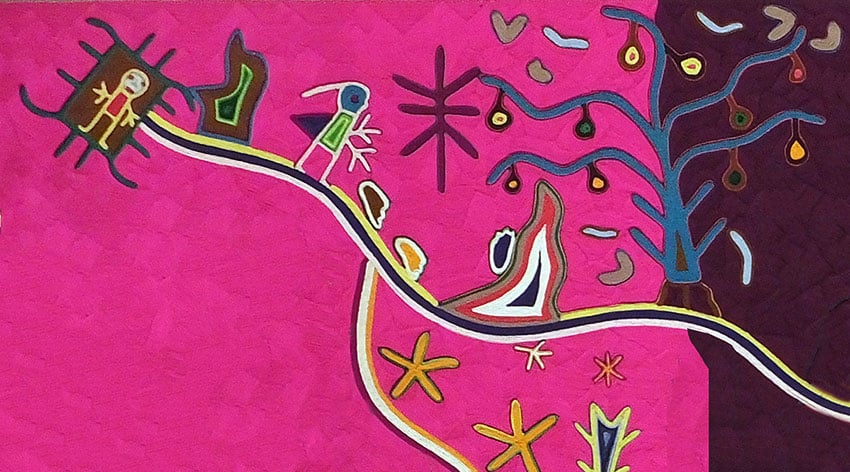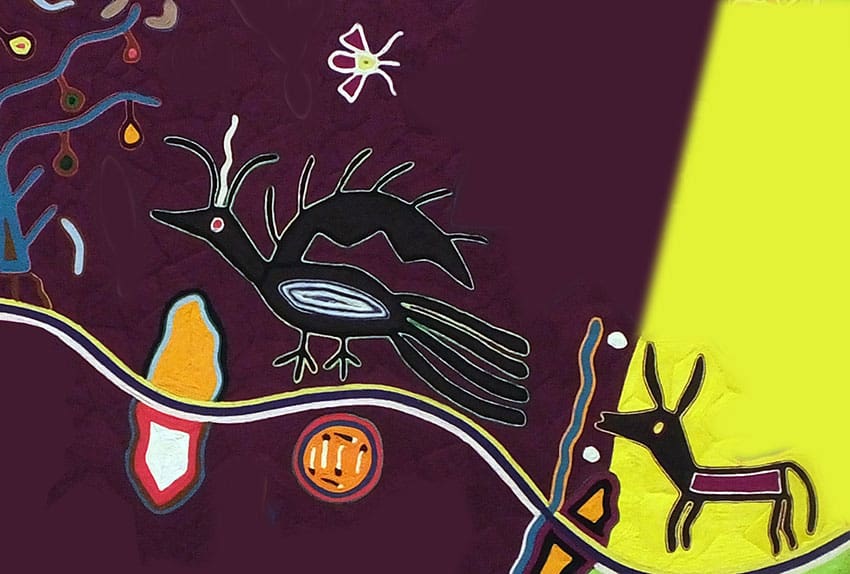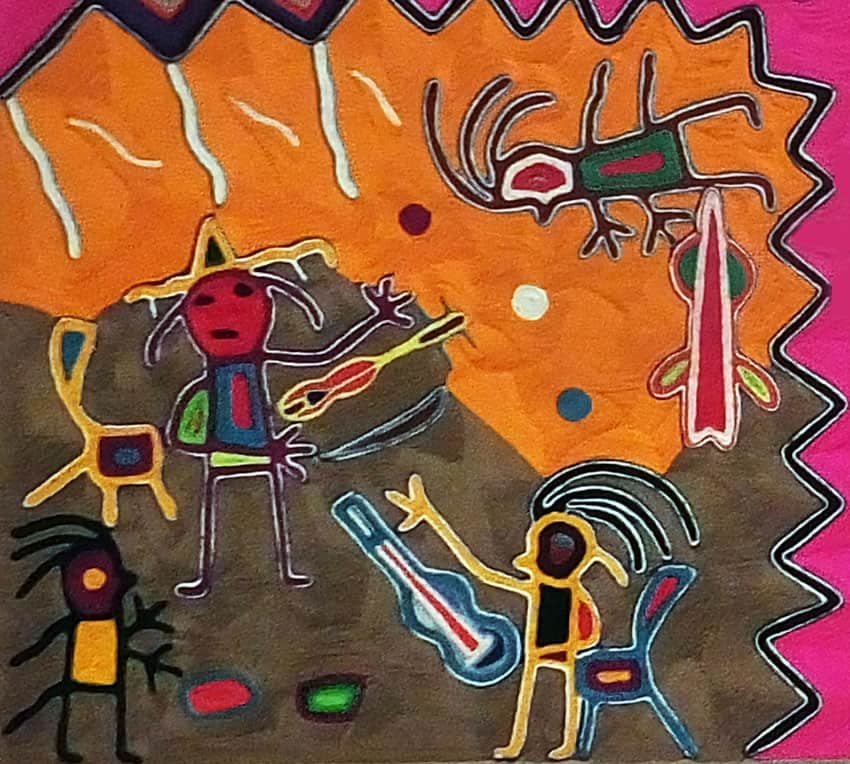Since last June, Guadalajara’s Instituto Cultural Cabañas has been hosting an exhibition of around 50 pieces of Wixárika (Huichol) art on loan from places like Harvard University and the Museum of Natural History in New York.
All of these are “yarn paintings” created by pressing colored yarn onto a flat surface covered with a mixture of beeswax and pine resin. Some of the pieces are so large I would call them murals.
The Wixáritari are an indigenous people living in the Sierra Madre Occidental range of western Mexico and, based on carbon dating from their sacred fireplaces, it seems they have been living right there for at least 15,000 years.
As I wandered through the six salons showing the art of this ancient people, I was mesmerized by the beauty of these brightly colored “yarn paintings” and at the same time deeply curious to know what all those mysterious images meant.
“You’re in luck,” said a friend, “next to every picture frame there’s a detailed explanation of what it’s all about.”

I walked up to one of these explanations (in Spanish), began to read, and instantly realized that simply locating the things that were described was going to be a daunting task, apart from the far greater challenge of actually understanding what the artist was trying to say to me — but, I thought, “This is why the descriptions are here: the artist wants us to look at them.”
The best I could come up with was to photograph both art and explanation and wait to do my analyzing at home.
Back at home, I discovered that these indigenous artists were telling some fascinating stories which revealed a great deal about how they look at the world.
Since there is still time for you to see the exhibit if you are located near Guadalajara, I’ll describe just one of the pictures, hoping I can entice you to go see the original at Hospicio Cabañas and perhaps investigate some others on your own.
The picture I want to describe is called El Viaje del Difunto by Guadalupe González Ríos: The Dead Man’s Journey (Image 1). It is practically a mural and so complex that I could imagine people discussing it for hours, maybe days. All I will do here is give a very brief synopsis of the two-page description which goes with the picture.
This is the story of a man who died and went to the underworld. Five days after his death, a shaman follows the man’s footsteps and attempts to rescue his soul.

In Image 2 we see the tomb of the dead man in the upper left corner and immediately to the right of it the nierika or portal which the shaman uses to follow the man’s footprints along the path. The dead man first comes to the sacred fig tree where newly arrived souls are obliged to throw objects at its branches.
Men must throw vagina-shaped rocks while the souls of women throw straight sticks. These elements, explains the artist, symbolize sexual transgressions.
Farther along the trail (Image 3, center) the voyager comes to a crow. In his lifetime, the man often frightened this crow while working in the fields, and now he must placate the bird, presenting it with an ear of corn and begging it for mercy.
Just beneath the crow, on the other side of the trail, we see an orange circle which represents a pool of dirty, parasite-infested water. This is what he must now drink in the underworld and it forces him to reflect on all the times he was able to drink clean and delicious water during his lifetime. “After death, everything is reversed,” comments the artist.
Now the hapless wanderer is transformed into a fly, which we can see above the crow’s wing. Unfortunately, the next thing he comes to is a river which cuts across the trail. To get to the other side, he must beg the help of a dog, whose ears seem, to me, curiously long.
“But the dog refuses,” we are told, “because the man used to kick and beat that dog and never gave it anything to eat.”

Luckily, the man had been buried with two tortillas, exactly for a situation such as this. These, I think, are represented by the two white circles near the dog. The dead man throws them to the dog and manages to cross the river.
After this, the poor soul undergoes all sorts of torments for his sexual misdeeds. These punishments typically include being skewered and roasted or being boiled alive. The worst punishment of all is dying a second time and this one is reserved for those who sinned by having sex with a mestizo.
At long last, the shaman catches up with our wanderer at — of all things — a party, where the souls of the dead are “dancing in wild abandonment” to violin and guitar music, raising clouds of dust. All this can be seen in the lower left corner of Image 4.
The shaman now fires an arrow into the dead man (long red triangle), “liberating him from all the possessions he brought with him to the underworld.” The shaman then washes him, gives him food and releases him into heaven.
In heaven (Image 1 — again), our lucky soul is received by the owner of the celestial realm, our Mother Young Eagle who, I think, is the large, white-faced figure at the far left of the full picture. Next to her you can see the small figure of a child.
It should be noted that for children there is a shortcut through the underworld, leading straight to heaven. This is represented in the yarn painting by a trail which forks off from the main trail (where we saw the footprints — remember them?) and passes through lots of flowers, finally arriving at a portal to heaven which is “for kids only.”

If you are now curious to see more of these yarn paintings, you will find the exhibit Grandes Maestros del Arte Wixárika (Grand Masters of Wixárika Art) in downtown Guadalajara at the Instituto Cultural Cabañas, which is open Tuesday to Sunday, 10:00am to 6:00pm but closed on Mondays. Tuesdays are free. Note that the Wixárika exhibit will end on December 31.
The writer has lived near Guadalajara, Jalisco, for more than 30 years and is the author of A Guide to West Mexico’s Guachimontones and Surrounding Area and co-author of Outdoors in Western Mexico. More of his writing can be found on his website.
[soliloquy id="96281"]
